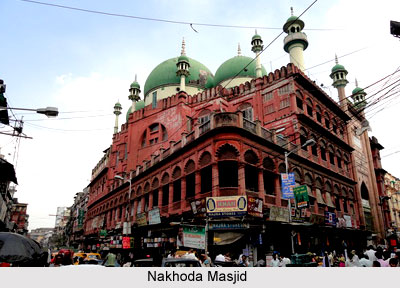 The Nakhoda Masjid is one the famous mosques of West Bengal. It is located in Zakariya Street, near the junction of Chitpore Road and Mahatma Gandhi Road of the Burrabazar business district in Central Kolkata. It lies at the intersection of Zakariya Street and Rabindra Sarani.
The Nakhoda Masjid is one the famous mosques of West Bengal. It is located in Zakariya Street, near the junction of Chitpore Road and Mahatma Gandhi Road of the Burrabazar business district in Central Kolkata. It lies at the intersection of Zakariya Street and Rabindra Sarani.
Construction of Nakhoda Masjid
Nakhoda Masjid was built in the year 1926 by Abdur Rahim Osman, a leader of the Kutchi Memon Jama`at. He was a shipping prince and a resident of Cutch. The mosque was named as Nakhoda meaning Mariner. The Masjid is a replication of the Akbar`s tomb in Sikandra which is an exquisite an example of Indo-Saracenic architecture. The foundation stone was laid on 11 September 1926.
Architecture of Nakhoda Masjid
The prayer hall of the Nakhoda Masjid has the capacity to encompass almost 10,000 men for performing the `Namaaz.` The masjid has three domes and two minarets which are 151 feet high. Apart from these there are also 25 smaller minarets which are which are 100ft. - 117ft. tall. The gateway of this mosque is an imitation of the Buland Darwaza at Fatehpur Sikri in Agra. To build this gate granite stones were brought from Tolepur. An exhibition also takes place, which displays amazing artistic extravaganza and decoration.
This article is a stub. You can enrich by adding more information to it. Send your Write Up to content@indianetzone.com





















